How The Dambusters Turned The Tide Of World War II
The Dambusters (617 Squadron) was formed in March 1943 with only one purpose in mind, a mission so important that even those taking part were not privilaged to the details until just before their top secret operation took place.

Derwent Valley: Image By Pleasure Flights
Based at R.A.F Scampton, the newly formed Dambusters were placed under the command of Wing Commander Guy Gibson. This must have been a difficult command for him, since although he was tasked with training his men for single audacious raid, even Wg Cdr Guy Gibson was left in the dark regarding the exact details of the mission to come.
617 Squadron began training on the 31st of March 1943, initially this consisted of low level flying and navigating at altitudes of under 100 feet. Around May 4th, training progressed to zero altitude flying over water, a task that many pilots had trouble with due to the difficulty of judging altitude with no visual point of reference. Training missions took place at night over Eyebrook Reservoir in Leicestershire, and the Derwent Valley in Derbyshire's Peak District.
Low level practice runs took place in Derwent Valley over Ladybower Dam, Howden Dam, and Derwent Dam, this did not make the Dambusters very popular with the locals, who were woken nightly by the deafening roaf of low flying Lancaster bombers. Some residents even wrote letters to the national press, complaining of a terrifying roar that shook their whole house in the middle of the night.
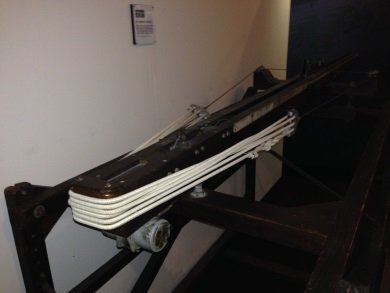
Although the Dambusters did not know it at this stage in their training, Barnes Wallis’s bouncing bomb would play a crucial role in the mission to come.
To the left is a photograph of the actual catapult used by Barnes Wallis to develop the bouncing bomb. It was used to fire scaled down prototypes across a test tank at the National Physics Laboratory.
In order to carry the bouncing bomb, 617 Squadron's Avro Lancaster bombers had to be specially modified. The cradle seen here allowed the bouncing bomb to be spun at up to 500 rpm.
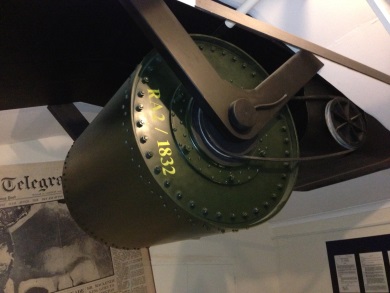
To prevent the bouncing bombs from vibrating when spun, and potentially tearing away from the aircraft, each bomb was test spun in a specially designed rig. Weights were added to the side of each bomb's casing to balance it, much like car wheels are balanced when new tyres are fitted.
Bouncing bombs were shielded against shock to prevent them from exploding when the bomb hit the water. Each bomb was also fitted with three naval hydrostatic pistols, these depth charges were actuated by water pressure, causing the bomb to explode once it reached a predefined depth.
The Dambusters practiced dropping dummy bombs at Reculver Beach in Kent. The practice bombs were filled with concrete rather than explosives, because blowing up Blighty is simply not cricket old chap!

Operation Chastise
At 6pm on the 16th May 1943, 617 Squadron were given their final mission breifing by Wg Cdr Guy Gibson. During this 2 hour breifing, Gibson introduced the Squadron to Barnes Wallis, informed them of their targets, and provided details of the plan.
617 Squadron departed in three groups, the first group consisting of nine Avro Lancaster bombers were tasked with targetting the Eder, Möhne, and Sorpe dams. The second group of five aircraft would depart ten minutes later, their target was Sorpe dam in Hochsauerland. The third group of five aircraft were backup, they would depart two and a half hours behind group one.
Flight Lieutenant Astell's Lancaster was part of the second group, it collided with high voltage wires shortly after entering Germany, and exploded into flames. The bouncing bomb attached to the undercarriage exploded shortly after, killing all seven crew members. They had been flying low to avoid flak guns.
Wave 1
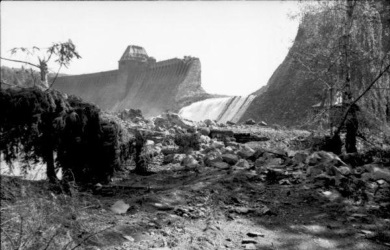
Wg Cdr Guy Gibson had flown with the first group, and arrived at Möhne dam just after midnight. His bomb was spun up to speed and dropped, but although it hit the face of the dam and exploded, it did not cause a breach. Next Hopgood commenced his bombing run, but as he approached his Lancaster was hit by flak guns positioned in defence of the dam. His port engine caught fire and the bouncing bomb was released several seconds late, causing it to bounce over the top of the dam wall. Hopgood's Lancaster broke up shortly after and crashed a few miles north west of the target. Two crew members managed to survive the crash by jumping from the burning plane with their parachutes already deployed.
Martin and Squadron Leader Dingy Young and Martin attacked the target next in turn, and although their bombs each hit the dams face, it still did not breach. Flight Lieutenant Maltby commenced his approach for the fifth attack, at first the dam appeared to be intact, but collapsed shortly after the impact releasing millions of gallons of water.
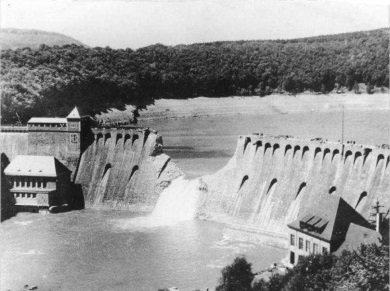
Dingy Young and Martin set a course for home, while Wg Cdr Gibson and the remaining three Lancasters still carrying a payload proceeded to the next target, the Eder dam. Shannon dropped his bomb on his third run after having difficulty achieving the right angle of approach. The bomb impacted with the dam but caused no visible damage. Maudslay attacked next but his bomb hit the top of the damn and exploded right behind his Lancaster. Maudslay attempted to return to base, but his damaged aircraft was shot down by light flak, there were no survivors. Les Knight was the last pilot to attack in wave one, his bomb bounced three times and stuck a direct hit on the Edur dam, causing a massive breach.
Wave 2
The second wave was plagued by misfortune, one Lancaster returned to base after loosing communications due to flak damage, another misjudged its altitude over the ocean, and tore the bomb carriage from its fusilage, the third hit a pylon and exploded, and the fourth was shot down by flak over the oceon. Only one Lancaster from wave two actually made it to Sorpe dam, and although the bomb was dropped on target, the dam held.
Wave 3
Wave three lost a further two planes, one was shot down by 20mm gunfire, the second crashed after the pilot was dazzled by a search light. Three Lancasters reached Sorpe dam, two of which scored direct hits, but the dam remained intact.
The Cost of War
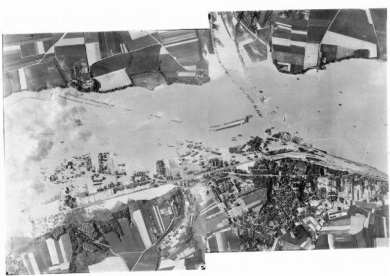
Squadron 617 lost 53 men during Operation Chastise, and German casualties were far higher. 1600 people were killed, 11 factories and 92 houses were destroyed, almost 7,000 acres of farmland were laid to waste and over six thousand livestock were killed.
Why Was The Ruhr Valley Targetted?
The Ruhr Valley was heavily industrialized, and it was feared that these factories could be repurposed to support the German war effort. Aerial intelligence also indicated that these dams contained one third of Germany's water supply and that their destruction would severely impede transportation, which was heavily reliant on waterways at that time.
How Did The Dambusters Change The Course Of WWII?
After Operation Chastise, the Dambusters went on to fly many other important missions that changed the course of the war. They destroyed Hitler's super gun, a weapon that would have been capable of shelling London with 10 supersonic shells every minute had it become operational. They also sank the 43,000 ton German battleship "Tirpitz", disrupted vital supply lines, and destroyed a major U-Boat factory.








